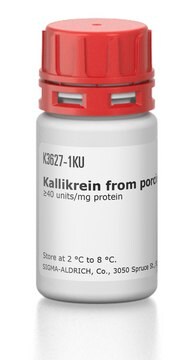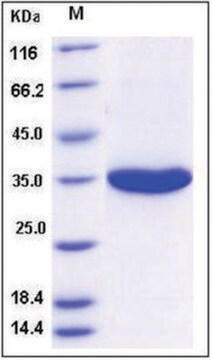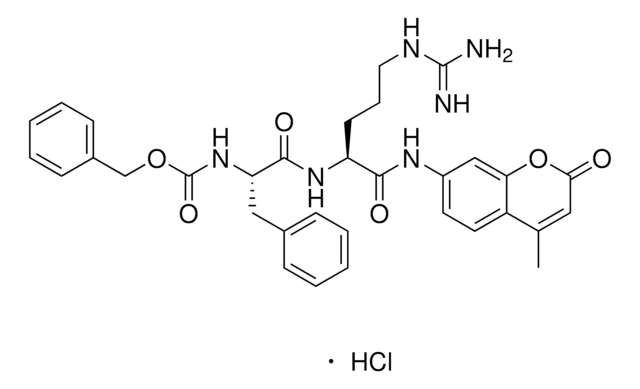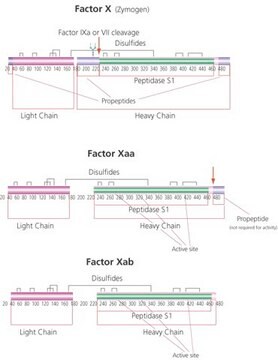K2638
Kallikrein from human plasma
buffered aqueous solution, ≥5 units/mg protein
Sinonimo/i:
Kininogenase, Kininogenin
Autenticatiper visualizzare i prezzi riservati alla tua organizzazione & contrattuali
About This Item
Numero CAS:
Numero MDL:
Codice UNSPSC:
12352204
NACRES:
NA.54
Prodotti consigliati
Stato
buffered aqueous solution
Livello qualitativo
Attività specifica
≥5 units/mg protein
N° accesso UniProt
Condizioni di spedizione
dry ice
Temperatura di conservazione
−20°C
Informazioni sul gene
human ... KLK1(3816)
Cerchi prodotti simili? Visita Guida al confronto tra prodotti
Descrizione generale
Kallikrein-related peptidases belong to the family of 15 highly conserved trypsin- or chymotrypsin-like serine proteases. Plasma kallikrein (PK) is a serine protease derived from plasma prekallikrein, a zymogen found at higher levels in blood circulation. The KLKB1 gene is located on the human chromosome at 4q35.2.
Applicazioni
Kallikrein from human plasma has been used:
- to culture human hepatocellular carcinoma cell line
- to study its effects on the cleavage of Neisserial heparin binding antigen (NHBA) from Neisseria meningitidis
- in peptidase inhibition assay
Azioni biochim/fisiol
Plasma kallikrein (PK) is involved in the synthesis of bradykinin, maintaining the blood metabolite levels and hypertension. It also participates in the activation of coagulation factor XII, which promotes inflammation and the intrinsic coagulation pathway. PK controls proteolytic cascades in the cardiovascular system like the kallikrein-kinin system, renin-angiotensin system, fibrinolytic system, and the alternative complement pathway. It is involved in the cleavage of glucagon-like peptide-1 (GLP-1) and neuropeptide Y (NPY) which suggests that plasma kallikrein may affect metabolism and diabetes.
Definizione di unità
One unit will hydrolyze 1.0 μmole of Nα-benzoyl-L-arginine ethyl ester (BAEE) to Nα-benzoyl-L-arginine and ethanol per min at pH 8.7 at 25°C.
Stato fisico
Solution in 20 mM Tris-HCl, pH 7.8 with 100 mM NaCl.
Codice della classe di stoccaggio
12 - Non Combustible Liquids
Classe di pericolosità dell'acqua (WGK)
WGK 1
Punto d’infiammabilità (°F)
Not applicable
Punto d’infiammabilità (°C)
Not applicable
Dispositivi di protezione individuale
Eyeshields, Gloves, multi-purpose combination respirator cartridge (US)
Scegli una delle versioni più recenti:
Possiedi già questo prodotto?
I documenti relativi ai prodotti acquistati recentemente sono disponibili nell’Archivio dei documenti.
I clienti hanno visto anche
Xueqing Xu et al.
Nucleic acids research, 37(22), 7381-7393 (2009-10-13)
A subtelomeric region, 4q35.2, is implicated in facioscapulohumeral muscular dystrophy (FSHD), a dominant disease thought to involve local pathogenic changes in chromatin. FSHD patients have too few copies of a tandem 3.3-kb repeat (D4Z4) at 4q35.2. No phenotype is associated
Elisa Pantano et al.
PloS one, 14(8), e0203234-e0203234 (2019-08-02)
Neisserial Heparin Binding Antigen (NHBA) is a surface-exposed lipoprotein of Neisseria meningitidis and a component of the Bexsero vaccine. NHBA is characterized by the presence of a highly conserved Arg-rich region involved in binding to heparin and heparan sulphate proteoglycans
H Austin et al.
Journal of thrombosis and haemostasis : JTH, 9(3), 489-495 (2011-01-15)
We evaluated 10 single-nucleotide polymorphisms (SNPs) identified in three European case-control studies as risk factors for venous thrombosis. We sought to replicate the positive findings from this report among Whites and to evaluate the association of these SNPs with venous
L E Stolz et al.
Drugs of today (Barcelona, Spain : 1998), 46(8), 547-555 (2010-09-11)
Hereditary angioedema (HAE) is a debilitating, potentially fatal disease characterized by variable and unpredictable acute attacks of swelling affecting the subcutaneous tissue and mucosa. It is an autosomal dominant disorder resulting from a genetic deficiency of functional C1-esterase inhibitor. Available
A new case of homozygous C1-inhibitor deficiency suggests a role for Arg378 in the control of kinin pathway activation.
Alberto López-Lera et al.
The Journal of allergy and clinical immunology, 126(6), 1307-1310 (2010-09-25)
Il team dei nostri ricercatori vanta grande esperienza in tutte le aree della ricerca quali Life Science, scienza dei materiali, sintesi chimica, cromatografia, discipline analitiche, ecc..
Contatta l'Assistenza Tecnica.












